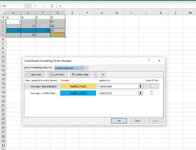UncleBajubjubs
Board Regular
- Joined
- Jul 11, 2017
- Messages
- 111
- Office Version
- 2010
Good morning, I have a table with 4 columns where columns A, B, and C can have an amount of money, and D a text string. It's intended that the the user will put in an amount of money into one of A, B, or C, and they will enter a value into column D for any rows that have anything in the previous columns.
In this table as an example, rows 1 and 2 are filled out correctly, but row 3 is wrong because both A and C have a value, and row 4 is wrong because there is a value in B, but nothing in D.
How might I set it so that so cells A, B, and C will be highlighted if more than 1 of the 3 have values, and D will be highlighted if there is no label when 1 of A,B, or C have a value?
Thanks
In this table as an example, rows 1 and 2 are filled out correctly, but row 3 is wrong because both A and C have a value, and row 4 is wrong because there is a value in B, but nothing in D.
| 56 | E1 | ||
| 22 | G6 | ||
| 71 | 34 | B2 | |
| 65 |
How might I set it so that so cells A, B, and C will be highlighted if more than 1 of the 3 have values, and D will be highlighted if there is no label when 1 of A,B, or C have a value?
Thanks






